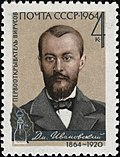Dmitri Ivanovsky
Dmitri Ivanovsky (1864–1920) was a Russian microbiologist who is considered one of the founders of virology. In 1892, he investigated a disease in tobacco plants, now known as the tobacco mosaic disease, and discovered the existence of non-bacterial pathogens that were invisible under a microscope and could pass through fine filters that retained bacteria. His findings were pivotal in the establishment of virology as a scientific discipline, although the significance of his discovery was not fully appreciated until later, with the work of Martinus Beijerinck who coined the term "virus" to describe the infectious agent.
Early Life and Education
Dmitri Ivanovsky was born in Gdov, Russia, in 1864. He pursued his higher education at the Saint Petersburg State University, where he studied under the guidance of the prominent botanist Andrei Beketov. During his studies, Ivanovsky showed a keen interest in plant pathology, which would later define his scientific career.
Research and Discoveries
In 1892, while investigating the tobacco mosaic disease, Ivanovsky used a Chamberland filter, known to remove bacteria from solutions, and found that the filtered sap from diseased tobacco plants could still infect healthy plants. This observation suggested the existence of an infectious agent smaller than bacteria, a groundbreaking discovery at the time. Ivanovsky's initial findings were published in an article where he cautiously described the infectious agent but did not speculate further on its nature.
Despite his groundbreaking work, Ivanovsky did not pursue the study of the infectious agent further. It was Martinus Beijerinck who, in 1898, replicated Ivanovsky's experiments and concluded that the agent was a new form of infectious agent, which he named "virus." Beijerinck's work built upon Ivanovsky's findings and is often credited with the foundation of virology as a field. However, Ivanovsky's contribution is recognized as the first step towards the discovery of viruses.
Later Life and Legacy
After his discovery, Ivanovsky continued his work in microbiology, focusing on other plant diseases and contributing to the field of phytopathology. He held academic positions and was respected in his field, although he did not gain the same level of international fame as some of his contemporaries. Dmitri Ivanovsky died in 1920, but his work laid the groundwork for the field of virology, influencing generations of scientists and leading to significant advancements in understanding viral diseases.
Impact on Virology
Ivanovsky's discovery of the tobacco mosaic virus opened the door to the study of viruses, a field that has become increasingly important in understanding disease mechanisms, developing vaccines, and addressing global health challenges. His work is a testament to the importance of basic scientific research and its potential to lead to significant breakthroughs.
See Also
- Ivanovsky.jpg
Dmitri Ivanovsky
Transform your life with W8MD's budget GLP-1 injections from $125.
W8MD offers a medical weight loss program to lose weight in Philadelphia. Our physician-supervised medical weight loss provides:
- Most insurances accepted or discounted self-pay rates. We will obtain insurance prior authorizations if needed.
- Generic GLP1 weight loss injections from $125 for the starting dose.
- Also offer prescription weight loss medications including Phentermine, Qsymia, Diethylpropion, Contrave etc.
NYC weight loss doctor appointments
Start your NYC weight loss journey today at our NYC medical weight loss and Philadelphia medical weight loss clinics.
- Call 718-946-5500 to lose weight in NYC or for medical weight loss in Philadelphia 215-676-2334.
- Tags:NYC medical weight loss, Philadelphia lose weight Zepbound NYC, Budget GLP1 weight loss injections, Wegovy Philadelphia, Wegovy NYC, Philadelphia medical weight loss, Brookly weight loss and Wegovy NYC
|
WikiMD's Wellness Encyclopedia |
| Let Food Be Thy Medicine Medicine Thy Food - Hippocrates |
Medical Disclaimer: WikiMD is not a substitute for professional medical advice. The information on WikiMD is provided as an information resource only, may be incorrect, outdated or misleading, and is not to be used or relied on for any diagnostic or treatment purposes. Please consult your health care provider before making any healthcare decisions or for guidance about a specific medical condition. WikiMD expressly disclaims responsibility, and shall have no liability, for any damages, loss, injury, or liability whatsoever suffered as a result of your reliance on the information contained in this site. By visiting this site you agree to the foregoing terms and conditions, which may from time to time be changed or supplemented by WikiMD. If you do not agree to the foregoing terms and conditions, you should not enter or use this site. See full disclaimer.
Credits:Most images are courtesy of Wikimedia commons, and templates, categories Wikipedia, licensed under CC BY SA or similar.
Contributors: Prab R. Tumpati, MD

